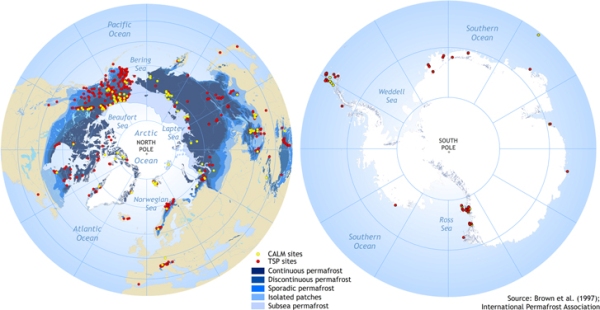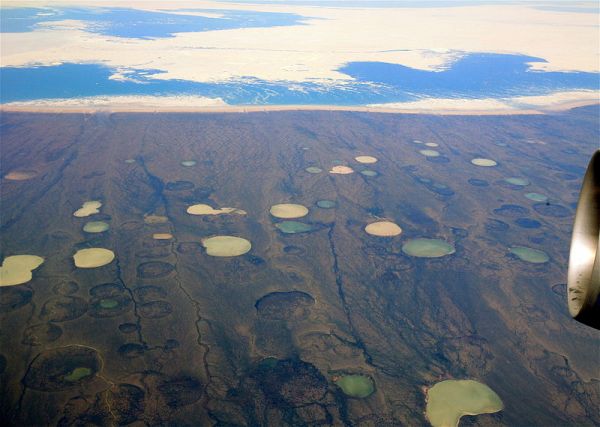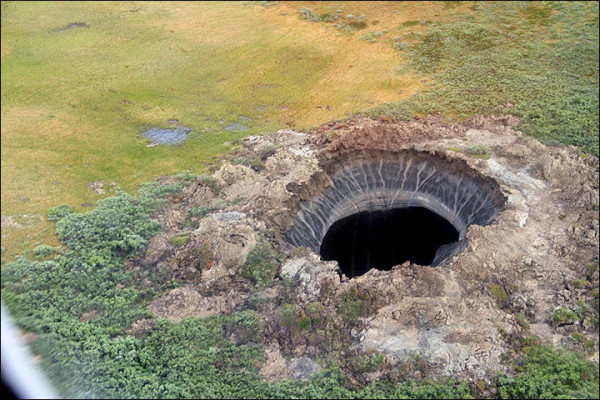From Canada to Siberia, Permafrost Thaw Produces ‘Hell’s Mouth’ Craters, Sinking Lands, and 7,000 Methane Pockets Waiting to Blow
In places like Canada and Siberia, a memory of ice ages long past is locked away in the very soil. There, dig about three feet down, and you’ll encounter a layer of frozen earth running from 200 feet to almost a mile deep in some places. It’s like a great glacier secreted away underground and covering about 19 million square kilometers of the Northern Hemisphere. We call this frozen ground permafrost.
An Enormous Pile of Sequestered Carbon
Permafrost generally forms in regions where the mean annual temperature is below zero degrees Celsius. And the presently large expanse of permafrost has formed over the past 2-3 million years in which long, cold ice ages and short, and somewhat warmer interglacial periods have dominated.
(Recent research indicates that up to 120 billion tons of carbon could release from thawing permafrost this Century due to the warming that is now being caused by human fossil fuel burning. Such a release would roughly equate to 12 years of present fossil fuel burning adding approximately 40 ppm of CO2 equivalent gasses to the Earth’s Atmosphere [adding about 0.4 C to medium term warming and 0.8 C to long term warming]. The risk posed by this additional carbon feedback coming from the Earth System highlights the need to halt fossil fuel burning as swiftly as possible. Image source: The Impact of Permafrost Carbon Feedback on Global Climate.)
Locked away in all that permafrost is a massive store of carbon. Including peat, methane and methane hydrates, permafrost is estimated to have sequestered some 1,400 to 1,700 billion tons of a material that, if released as gas, could considerably contribute to the volume of heat trapping substances (like CO2 and CH4) already held aloft in the Earth’s atmosphere in a process that scientists call an amplifying climate feedback.
Evidence of Thaw and a Building Carbon Feedback
But now, human fossil fuel burning is causing the Arctic to rapidly warm — at about 3 times faster than the rate of warming for the rest of the globe (0.6 C per decade in the Arctic). And with atmospheric CO2 concentrations presently above 400 parts per million (and CO2e concentrations above 490 parts per million), the world is now starting to thaw out of the icy period of the last 2-3 million years. As a result, the permafrost is melting.
(Thermokarst lakes near Hudson Bay. Image source: Commons.)
When permafrost melts it changes the land around it. Often times, land subsides and deforms as the icy permafrost below collapses when it thaws. The resulting underground cavities can also telegraph to the surface in the form of sink holes. In places where microbes or hydrates are present, the cavities can fill with gas — which can sometimes erupt in a methane blow hole or ‘hell’s mouth’ crater. In Canada, a new study recently discovered that 52,000 square miles of northwestern permafrost is already thawing. The thaw is producing large sink holes, causing coastlines to rapidly erode, and proliferating the round ponds known as thermokarst lakes.
But it’s not just Canada that’s feeling the thaw. In Siberia, warming is also eating away at the permafrost. And what is happening there is arguably on a much grander and more disturbing scale than what we presently see in Canada. In East Siberia, for example, a 100 meter deep, 1 kilometer long crater has formed in the sagging Permafrost. It is officially called the Batagaika crater. But the locals know it as the Gateway to the Underworld. The crater began as a small deformation during the 1960s when permafrost thaw in the region initiated. It has, over the decades, grown considerably larger — with the growth rate accelerating along with permafrost melt during recent years.
(Time lapse of Batagaika Crater expansion from 1984 to 2016 as provided by Google’s Earth Engine.)
Further west, the Yamal region of Russia is seeing strange bulges dispersing across the land. The bulges, according to Russian scientists and to reports in the Siberian Times, are being caused by bubbles of methane gas beneath the surface. The scientists state that these formations are likely being triggered by warming — in which either methane hydrates trapped within the permafrost are thawing or where microbes have come in contact with thawed permafrost carbon to break it down and produce methane. And in recent years, this region of Arctic Siberia has seen some very warm temperatures — with readings hitting as high as 35 C (95 F) during the summer of 2016.
These same researchers now note that some 7,000 underground methane bubbles exist in this region and that warming is pushing them to erupt. When the pressure below the land surface reaches a critical point, the Siberian Times report suggests that the land above can be displaced — bursting outward. The Siberian Times went on to note that large holes forming in the Yamal region during 2014 and 2015 were caused by just this kind of methane eruption.
(The Yamal Crater was one of the first indications that methane pockets forming beneath the Siberian Tundra were starting to erupt due to human-forced warming. Image source: The Siberian Times.)
Touchy Subject Scientifically and Politically
Permafrost thaw producing high volumes of feedback carbon release can be a touchy subject in the sciences and politically. The reason is that rational responses to this threat moves decision points forward on human carbon emissions cuts and it adds to the concern that atmospheric carbon capture will be needed later this century and on through many centuries to follow in order to prevent a scenario in which carbon feedbacks cause a form of warming runaway.
It doesn’t help that the science on permafrost carbon feedback is also new and rife with uncertainty — generating a kind of gray area in which rumors and misinformation can multiply. And there also appears to be some indication that the fossil fuel industry is attempting to use the issue to push gas extraction and burning in the Arctic — falsely claiming that all of the gas is going to release anyway. Which is not true — a portion of the permafrost carbon and related methane would remain sequestered even as human extraction efforts, if they continued indefinitely, would ultimately result in the release of a much larger portion of this carbon to the atmosphere than mere feedbacks alone.
It is worth noting that presently accepted science indicates that the present rate of atmospheric carbon release due to fossil fuel burning is likely many times that of the potential annual carbon release coming from the permafrost even under the worst case warming scenarios. And because that realized rate of permafrost carbon release is directly tied to how much fossil fuel we ultimately burn, we should be very clear that the urgency to cut these emissions couldn’t be higher.
Links:
Hat tip to Colorado Bob
Hat tip to Cate
Hat tip to Andy in San Diego






Geen opmerkingen:
Een reactie posten